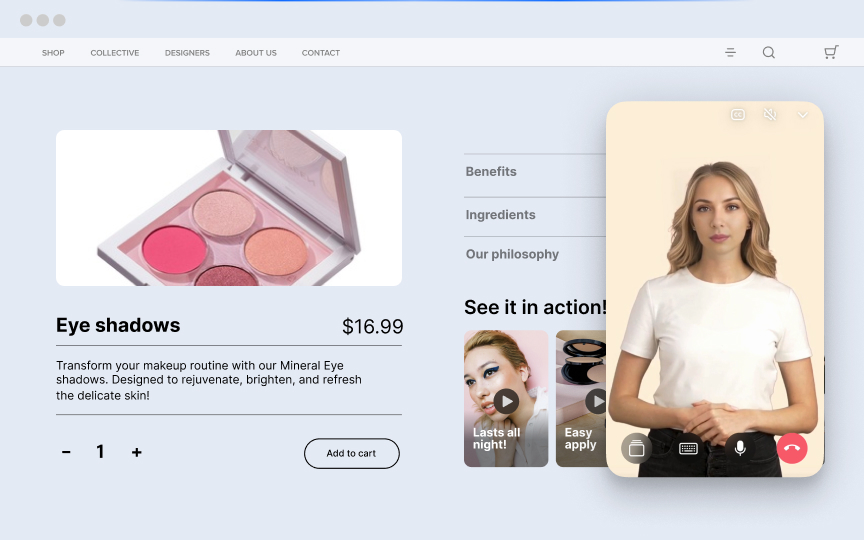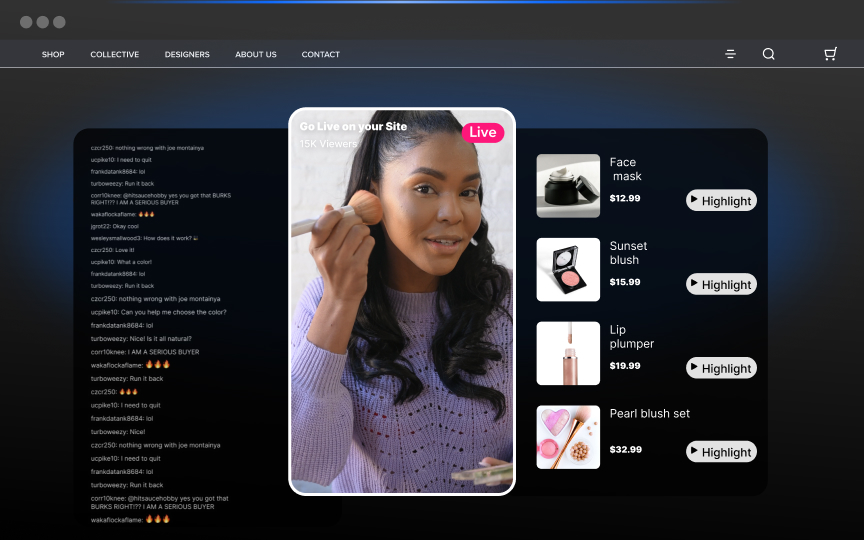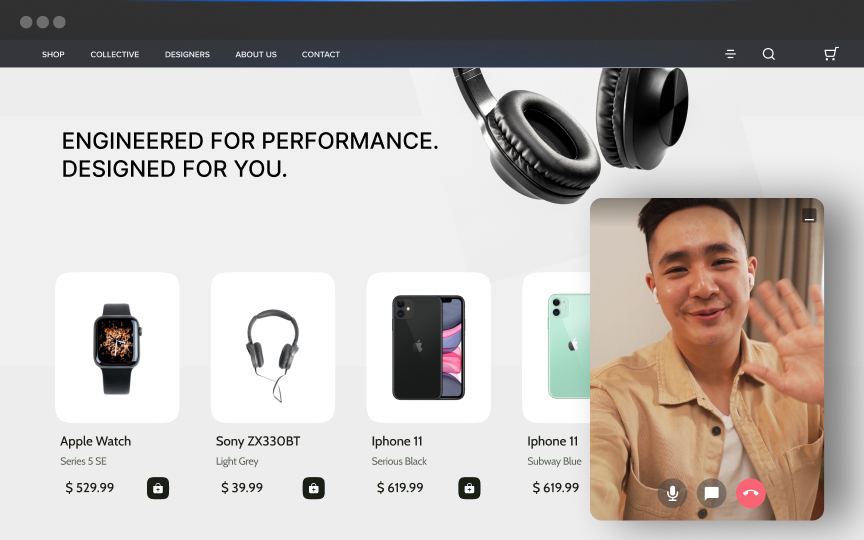E-commerce has been a game-changer in retail, transforming the way we shop by making it more accessible and convenient than ever before. Yet, it's not without flaws. The pandemic put a spotlight on some of e-commerce's inherent limitations, such as disappointingly low conversion rates and a glaring absence of human interaction. These limitations aren't just technical roadblocks; they hinder the ability of brands to form meaningful relationships with their customers, which is crucial for long-term loyalty and sustained growth. Video commerce comes into play as a revolutionary next step, effectively addressing these issues by seamlessly blending the ease of online shopping with the intimacy and engagement of in-person experiences. Unlike traditional e-commerce, video commerce enables brands to create dynamic, interactive spaces where customers can ask questions, get instant feedback, and even see products in action, all of which help humanize digital transactions. By making room for these richer, more personalized interactions, video commerce does more than solve the problems of its predecessor—it fundamentally transforms how brands can connect with, engage, and build strong, lasting relationships with customers. It's not just a minor update; it's a paradigm shift that is redefining the meaning of customer experience in online retailing.
Limitations of Traditional E-commerce
Before we delve deeper, let's identify the three major challenges that traditional e-commerce faces:
- Low conversion rates
- High return rates
- Lack of human interaction
The Conversion Challenge: According to recent statistics, the average conversion rate for e-commerce websites is just 2.86%. This means that less than three out of every 100 visitors to an e-commerce site actually end up making a purchase. Traditional e-commerce struggles to turn casual browsers into committed buyers, clearly indicating an area for improvement.The Return Rate Issue: E-commerce also suffers from a disproportionately high rate of product returns, which industry experts place between 20-30%. This is in stark contrast to the 8-10% return rates typically seen in physical retail stores. The inability to physically inspect or try on a product before purchase, along with misleading or insufficient product descriptions and images online, contribute to this disparity.The Human Element Gap: One of the most significant shortcomings of the traditional e-commerce model is the complete absence of human interaction during the buying process. Shoppers often have questions or seek guidance, and without real-time assistance from knowledgeable sales representatives, many customers find themselves lost in a sea of options. This lack of personal touch often results in low conversion rates and heightened product returns.
What is Video Commerce?
Video commerce is an elevated form of e-commerce that utilizes video to engage customers and facilitate the buying process. Unlike traditional e-commerce, which largely relies on still images and text descriptions, video commerce uses dynamic, interactive video content to enrich the customer experience. It's not just the future; it's already here, transforming every stage of the buyer journey—discovery, consideration, and purchase.The backbone of video commerce includes three main components:
- Short, Shoppable Videos. These are concise, pre-recorded videos that effectively showcase a product's features and benefits. They are often embedded on a product page and include clickable links or call-to-action buttons, making it seamless for viewers to transition from watching to purchasing.
- Livestream Shopping. This real-time interaction allows a host to showcase products, answer viewer questions, and facilitate purchases all in the moment. It's not just a way to shop; it's an interactive, personal experience predicted to become a $35 billion industry in the U.S. by 2024.
- Video Ads.These are brief, targeted videos designed to catch the viewer's attention and drive action. Video ads often include a call to action or a direct link to a product, with the added capability of one-click checkout for an ultra-smooth buying process.
These tools are enabling brands to craft customer-first experiences that are not just transactional but also interactive and engaging. From live Q&A sessions to embedded product links, video commerce is revolutionizing how consumers discover, consider, and ultimately purchase products online.
How Video Addresses E-commerce Limitations
One of the most compelling advantages of video commerce is its ability to hold viewers' attention for longer periods. Unlike static images and text, video captures motion and narrative, keeping the viewer's attention for longer stretches of time. The immediate result is a decrease in bounce rates and an increase in time spent on the site. When customers are more engaged, they're more likely to explore the product range and ultimately, to convert.Traditional e-commerce models have struggled to replicate the in-store human interaction that many shoppers value. Video commerce changes the game by introducing real human elements into the digital shopping experience. Whether it's a live Q&A session, a product demo by a brand ambassador, or personalized video recommendations, the medium fosters a sense of trust and authenticity. This human touch quells uncertainties, assuages doubts, and creates a more comfortable, confident shopping environment.Perhaps the most striking piece of evidence in favor of video commerce comes from its impact on conversion rates. Early research reveals a whopping 14.4% conversion rate for product pages featuring video content, a rate that's over five times higher than the 2.8% average seen in traditional e-commerce. The reasons are clear: video offers a more comprehensive view of the product and can tackle common questions and misconceptions in real-time. By reducing the barriers of uncertainty and information gaps, video commerce becomes a potent driver of conversions.
Trends in Video Commerce
The fast-evolving world of video commerce is being reshaped by a variety of groundbreaking trends, each enhancing the way brands connect with their customer base. Chief among these trends is the explosive growth of short-form video content, most notably popularized by platforms like TikTok and Instagram Reels. These platforms specialize in videos that are not only brief—often under 60 seconds—but also highly engaging and optimized for mobile consumption. Reports underscore the efficacy of such short-form content by pointing to click-through rates that are up to 73% higher than those generated by traditional video ads. This makes them an invaluable tool for brands looking to maximize consumer engagement and conversion rates.Live streaming, complemented by 1:1 video chats and digital showrooms, is taking video commerce to the next level. Live streams offer real-time brand-customer interaction, while 1:1 video chats serve as virtual shopping assistants, answering questions and offering guidance. Digital showrooms, acting as virtual store extensions, provide immersive ways for customers to engage with products. These features collectively strengthen customer trust and deepen brand relationships.Additionally, AI-powered video commerce is revolutionizing personalization. Machine learning algorithms adapt video content to individual preferences, dramatically increasing engagement and conversion rates. This technological edge sets brands apart, offering consumers a shopping experience that is not just advanced but also uniquely tailored. As these trends converge, the future for video commerce is not just promising—it's transformative, offering richer and more personalized shopping experiences.
Conclusion: The Future of E-commerce is Video
E-commerce has been groundbreaking, but it's not without its limitations—chief among them are low conversion rates, high return percentages, and a lack of human interaction. Video commerce emerges as the solution to these hurdles, providing a more engaging and effective shopping experience for consumers and boosting sales for businesses.This isn't just a minor update; it's a paradigm shift. Video content captures attention, encourages engagement, and brings back the human element that's often missing in online retail. With impressive conversion rates and advanced AI capabilities, video commerce is not just the future; it's the new standard.As we navigate this shift, the question for businesses is not if but how quickly they can adapt to this burgeoning model. Video commerce is here to stay, redefining the landscape of online retailing. It's high time for businesses to tune in or risk tuning out.Start your video commerce journey today! Book a demo now!
Unlock Exclusive Insights
By submitting this form, you agree to Firework's privacy policy and consent to receive personalized marketing communications. You can unsubscribe at any time.

































